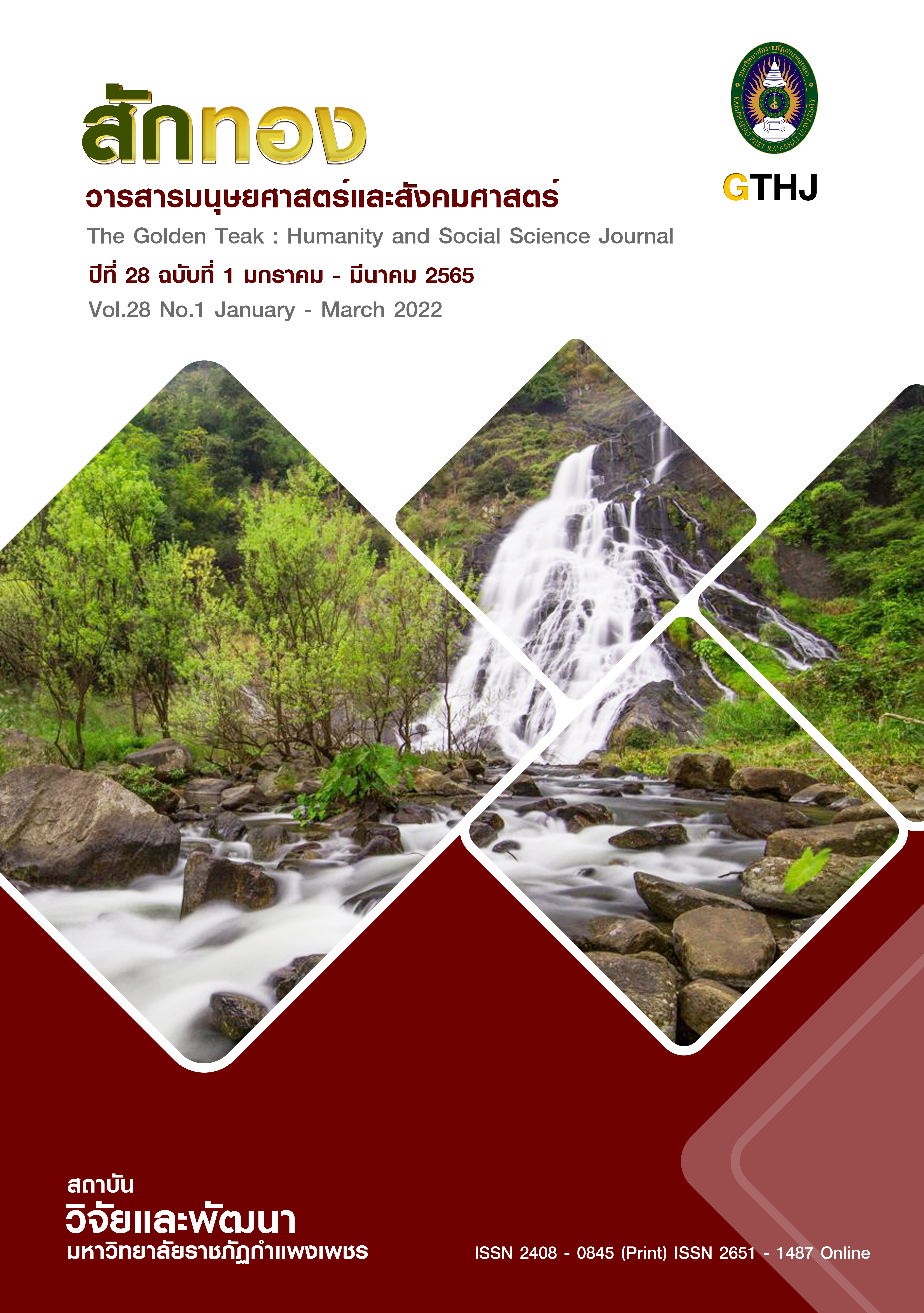Hua Daeng Teen Gan Sarong : The Origin And Identity of the Woven Fabrics Thai Lom
Main Article Content
Abstract
This qualitative research aims to study the background of the Hua Daeng Teen Kan Sarong, or the red Thai sarong with transverse stripe bottom, and the identity of the Thai Lom local fabric, Lom Sak and Lom Kao districts, Phetchabun. The information has been collected by interview, group discussion, and observation. The study population is 30 Thai Lom local weavers in Lom Sak and Lom Kao districts, Phetchabun. The information is validated with triangulation by dialogue, presentation, and synthesis and interpretation. In terms of the background of the sarong, the study found that Thai Lom people were descended from Luang Pra Bang, Laos, which was primitively Lan Chang Kingdom. There are two beliefs about the habitat and the ancestors. The first belief is that “Muang Lom” was a Lao community which had been expanded since the Sukhothai period. This belief is supported by historical evidence, which is the Sukhothai inscription. The second belief is that the ancestors of Thai Lom were exiles or emigrants from Laos during or after the Lao-Siamese War in the reign of King Rama III. Based on the aforementioned evidence, Thai Lom people have their own dress culture of women which is an influence of the Lan Chang-Luang Pra Bang Culture. This is reflected through Mudmee sarong from the waistband to bottom part. The waistband part is woven in with the continuous supplementary weft technique. Mudmee sarong is in the long middle part. The bottom part is sewn onto the middle part in transverse stripe patterns. This type of sarong looks similar to the sarong of the female of Luang Pra Band in the past. In terms of the identity of Thai Lom local fabric, the study found that the local fabric is “Sarong” which is woven from three pieces of fabric: the waistband, the body, and the bottom. Thai Lom people often call it “Hua Daeng Teen Kan Sarong” or “Kan Noi Sarong”. The waistband is dyed in red, which is why it is called “Hua Daeng”, or a red head. There are two types of the red heads: the continuous-supplementary-weft head which employs sharp sticks to make patterns, and the tie-dyed head, or Hua Yum in Thai Lom language. The later one is made by binding a white fabric into 7-10 small diamond shapes, and dying in red. The body, sewn onto the head, is the unique textile which is woven in quadrilateral patterns in a horizontal row of Mudmee technique. The patterns on the sarong can be divided into three groups. The first one is the main patterns which are Prasat Phung or Haw Prasat, Kho, Khapia, Mak Jub, and Uea or Eia patterns. The second pattern is the mixed patterrns which are Haw Prasat Ohp Daeng, Nak Tong Daeng or Nak Tong Pung patterns. The third one is the patterns which are Dok Kaew, and Ohk Mangmoom patterns, which can be generally found in some particular communities. There are five color shades appearing on the sarong: purple, gold-brown, candy pink, and navy blue. The bottom, the lowest part of Hua Daeng Teen Kan sarong, is woven in transverse patterns. The base color is normally black, blue, or purple. The transverse patterns are normally woven with red, green, and white. The textile is sewn onto the body afterwards, which is the reason people call “Teen Kan”, or transverse striped bottom in the dialect.
Article Details

This work is licensed under a Creative Commons Attribution-NonCommercial-NoDerivatives 4.0 International License.
บทความที่ได้รับการตีพิมพ์เป็นลิขสิทธิ์ของวารสาร สักทอง : วารสารมนุษยศาสตร์และสังคมศาสตร์ สถาบันวิจัยและพัฒนา มหาวิทยาลับราชภัฏกำแพงเพชร
ข้อคิดเห็นใดๆ ที่ปรากฎในวารสารเป็นวรรณกรรมของผู้เขียนโดยเฉพาะ ซึ่งมหาวิทยาลัยราชภัฏกำแพงเพชรและบรรณาธิการไม่จำเป็นต้องเห็นด้วย
References
Chaipratoom, J. (2011). Luang Prabang Woven Fabrics: The Dimensions of Culture and Traditional Knowledge. Journal of Fine and Applied Arts Khon Kaen University, 5(1), 129.
Chudhavipata, W. (2012). Reflection of Thai traditional. Research report. Bangkok : Dhurakij Pundit University.
Department of culture promotion. (2014). Lanna wisdom. Journal of Culture, 53(3), 8.
Fabric Museum Naresuan University. (2016). Information of Thai fabric in the lower northern region-Mueang Phetchabun cloth. [Online]. Available : http://www.thaitextilemuseum.com. [2018, July 20].
Inkai, N. (2018, 17 June). Sage of Local woven. Interview.
Kaewthep, K. & Chaikunpol, N. (2012). New media study guide. Bangkok : Pappim.
Kaewyom, S. (2018,17 June). Sage of Local woven. Interview.
Kondee, T. (2018, 7 July). Sage of Local woven. Interview.
Kromkong, A. (2018, 5 April). Sage of Local woven. Interview.
Lomsak Museum. (2018). The origin of Thai Lom. Public relations publication.
Mouhot, A. (2018). Travels in the Central Parts of Indo-China (Siam), Cambodia, and Laos. (Translation by Jansang, K.). (4 th ed.). Bangkok : Matichon.
Phasuk, S. (2002). Handwoven Thai Silk. Bangkok : Odeon Store.
Phutchong. C. (2006). Communication foradaptation and identity presentation of Sakais indigenousimmigrating to town community. Master of Communication Arts Chulalongkorn University.
Seevisit, P. (2009). Phitsanulok's famous fabric. Phitsanulok's famous fabric. [Online].
Available : https://sites.google.com/site/wisdom1305/phumipayya-thxng-thin-kar-thx-pha. [2018, July 15].
Tai Lom Art and Culture Conservation Club, Moon-Mang, Tha Kok Kae Temple. (2019). Evidence that confirms the identity of Lom Sak city. [Online]. Available : https://www.facebook.com/569429646478007/photos/a.578318495589122/1363679570386340/?type=3&theater. [2019, September 20].
Teangket, et al. (2009). The importance of local woven fabrics. [Online]. Available : https://spoketextiles.com/wp-content/uploads/2018/10/2 [2018, July 15].
Textile center of Chiang Rai Rajabhat University. (2006). Knowledge of Lanna textiles. Chiang Mai : Tonecolor.
Thai Heritage Treasuty. (2019). Local woven fabric Phetchabun. [Online]. Available : http://www.thaiheritage.net/nation/oldcity/phetchabun7.htm [2019, September 20].
Thang E-Shann. (2014). Lao communities in central Siam. [Online]. Available : http://e-shann.com/?p=8794. [2018, November 16].


